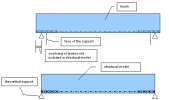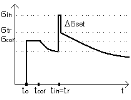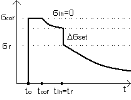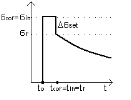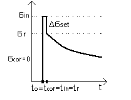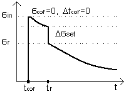Properties
of pre-tensioned tendons
In service Concrete Advanced in Design Defaults > Reinforcement and reinforcement design > Prestressing pre-tensioned
can be used to define general properties and type of stressing of pre-tensioned
tendons.
|
Type
of stressing
|
See the figure below the table.
|
|
Anchorage
set
|
Anchorage set at stressed end of tendon.
|
|
Initial
stress
|
Specifies the initial stress at stressed
end of tendon (before seating).
|
|
Stress
during correcting
|
Defines the stress at stressed end of tendon.
The amount of relaxation can be decreased by keeping the stress
constant (so called correction of relaxation).
|
|
Duration
of short-term relaxation
|
Specifies the time period between the end
of correction of relaxation (if any) and time of anchoring.
|
|
Duration
of keeping stress
|
The duration of keeping constant stress
during correction of relaxation.
|
|
Anchorage
length
|
The length of development of bond between
the concrete and pre-tensioned tendon.
|
|
Length
of prestressing units
|
Total length of wires or strands (between
wedges); for pre-tensioned concrete it is equal to the length
of stressing bed plus the length of abutments, see Fig. Pre-tensioned
beam.
|
|
Distance
between sections for output
|
Defines sections where results are given.
|
|
Length
of stressing bed
|
self-explanatory
|
|
Shortening
of stressing bed due to stressing of all prestressing units
|
self-explanatory
|
|
Coefficient
of thermal expansion of stressing bed
|
self-explanatory
|
|
Temperature
of prestressing units and stressing bed at stressing
|
self-explanatory
|
|
Temperature
of prestressing units at the time when bond exists
|
self-explanatory
|
|
Temperature
of stressing bed at the time when bond exists
|
self-explanatory
|
Pre-tensioned beam
Input of overhang
a) The user defines the real
length of the tendon - this length includes also the overhang length (only
prestressing losses are calculated on this real length of the tendon).
b) The user inputs the overhang-length
on both ends. These overhang lengths are then subtracted from the total
real length of the tendon. The length of the tendon used in the FEM calculation
equals to the real length of the tendon decreased by the overhangs on
both ends.
Example
Beam with length of 10.0 m,
tendon with length of 11.0 m and overhangs 0,5 m on each end. → The
tendon length for calculation of losses = 11.0 m; tendon length for FEM
calculation = 10.0 m
Type of stressing
|
Type
1
|
|
|
Type
2
|
|
|
Type
3
|
|
|
Type
4
|
|
|
Type
5
|
|

